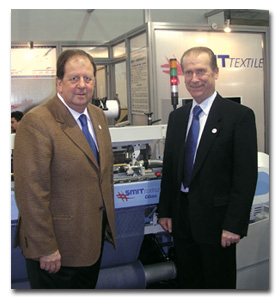W
ith the consolidation in recent years of weaving machine manufacturers, a new landscape
of weaving technology has emerged. The European Union’s Antitrust Commission, identifying a
dominant market position among the three major European weaving machine manufacturers, called for a
splitting of activities, creating an opportunity for an independent SMIT S.p.A. to re-emerge.
Italy-based SMIT offered the first rapier weaving machine to the market at the end of the
1950s. Since the 1960s – while under the ownership of Nuovo Pignone, Italy, and more recently under
Sulzer Textil, Switzerland – SMIT has continuously designed weaving machines that qualify as
technological and performance reference models.

Francesco Cecchinato (left), area sales manager, and Luciano Corain, president and managing
director, show SMIT’s G6300 at ShanghaiTex.
SMIT, whose majority shareholder is Borgosesia S.p.A., Italy, remains firmly committed to the
technical content of its products, while including commercial organization and service as
fundamental production elements.
SMIT’s production plant is equipped with the most sophisticated automated production systems.
Over time, the company has produced more than 40,000 gripper weaving machines, with many still in
operation around the world.
The weaving process inevitably is evolving, but it must retain characteristics to make unique
woven fabrics for specific applications. Performance improvement, simplified management and cutting
of machine costs must continue, while also meeting needs dictated by fashion fads, new fibers and
yarns, and new technical applications.
SMIT approaches product development in full compliance with the aforementioned parameters,
while utilizing innovative criteria ranging from competitive analysis to benchmarking, and from
quality function development to risk management.
A weaving machine actually is a series of machines coordinated and synchronized according to
the weaving process. One can thus understand how, all in all, substantial progress is being made –
with productivity increases in the order of 30 percent achieved in the past 10 years – yet the
machine continues to operate as efficiently as always.
New machines use new light alloys or composite materials, mechanical processes, surface
treatments, electronics and servo motors. These units offer, on the whole, highly effective,
innovative potential. Research involves an onerous commitment in resources and costs, which affect
mass production costs. A product range must compete in all application sectors and markets.
Research has induced SMIT to develop a product line with distinct characteristics that include
multigenerational features, modular structure and multifunctionality.
The development of such a product line requires lengthy involvement and ongoing objectives.
Various models are made in sequence, and the needs of each, with regard to common parts, are
determined progressively through interactive methodologies. SMIT has pursued this program with a
view to developing a common platform on which it could build diverse loom models designed for
specific technological applications. The first step taken in this direction was the G6300 showcased
at ITMA ’99. It was followed by specialized versions for technical fabrics, the G6300 F for terry
cloth and the JS900 – an air-jet model exhibited at ITMA 2003.
Without wasting resources and costs, SMIT has presented a complete product range encompassing
various application sectors and individual specific segments. Standardization and modular structure
allow cost reduction without jeopardizing product quality. Design work is focused on a less
dispersed area, and therefore development times are shortened; this leads to a shorter time to
market for innovations. Production also benefits from flexibility.
Since the 1960s, SMIT has had a commitment to research. It now has emerged once again to
serve the weaving industry.
March 2004




